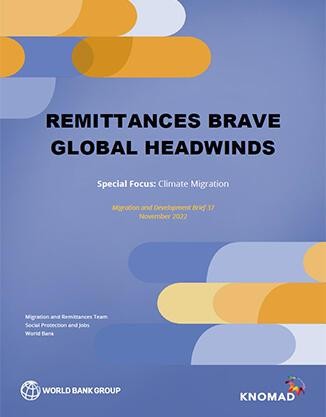By Dilip Ratha
We just released the latest Migration and Development Brief 37: Remittances Brave Global Headwinds with a Special Focus on Climate Migration. Against the odds, remittances to low- and middle-income countries (LMICs) in 2022 grew at an estimated rate of 5 percent to reach $626 billion. This growth is despite the worsening global situation and economic uncertainties.
Remittance flows to developing regions were shaped by several factors in 2022. First and foremost, a robust pace of growth in remittances is evidence of migrants’ determination to help their families back home. Their ability to send money home was supported by a gradual reopening of various sectors in host-country economies (following pandemic-induced closures and travel disruptions) which improved their incomes and employment situations. Rising prices, on the other hand, adversely affected migrants’ real incomes and remittances.
Currency exchange rates affected remittance flows: in the case of Russia, an unexpected and strong appreciation of the ruble translated into higher value, in US dollar terms, of outward remittances to Central Asia and the Southern Caucasus countries. In the case of Europe, a weaker euro had the opposite effect of reducing the US dollar valuation of remittance flows to North Africa and elsewhere. Finally, in many countries that experienced scarcity of foreign exchange and multiple exchange rates, officially recorded remittance flows declined as flows shifted to alternative channels offering better exchange rates.
Two other region-specific factors are of note. Transit migration and, therefore, remittances received by migrants in transit, continued to be strong in Mexico and Central America. In Europe and Central Asia, rising oil prices, in conjunction with the post-pandemic rebound in Russia’s demand for migrant workers and payments to Russian individuals and companies that relocated abroad following the onset of the war, increased the flow of remittances to Central Asian and Southern Caucasus countries.
The global average cost of sending $200 to LMICs was 6 percent in the second quarter of 2022, not very different from a year ago and twice as high as the SDG target (Remittance Prices Worldwide Database). Among developing country regions, it was cheapest to send South Asia (4.1 percent), while Sub-Saharan Africa had the highest average cost of about 7.8 percent.

Regarding migration, preliminary data indicate that official migration flows are rebounding from the pandemic-induced decline during 2020–21. While the recovery in migration seems very strong in the United States, in the Euro Area, migration flows have not returned to pre-COVID levels. However, undocumented migration to the European Union and the United States appears to be rising. Refugee flows also are increasing: 7.8 million Ukrainians have crossed into the EU since the start of the Russia-Ukraine war.
In a special feature, the brief notes that rising pressures of climate change will increase migration and impair livelihoods. Climate change is emerging as a potent driver of mobility. Stronger storms, increased flooding, intensifying heat and drought, and rising sea levels are already forcing people to leave their homes and sometimes their countries. Such extreme events are expected to increase in the years ahead. The World Bank’s Groundswell report estimated that internal climate migration may reach 216 million people by 2050 due to slow-onset climate impacts.
While most climate-related mobility has been and is expected to be internal, it could spill over into neighboring countries, especially among small island nations facing risks to their habitability. Most vulnerable to the negative impacts of climate change are those who are immobile in threatened areas. The poorest are likely to be most affected as they often lack the resources necessary to adapt or move.
Safe and regular migration needs to be considered as a part of adaptation strategies that include labor mobility and decent work, humanitarian admission and stay, family reunification, visa waivers, and legal pathways. Policy solutions must be considered for people who want to move, those who are already on the move, and those who would stay in place. Efforts are required across several aspects of migration policies at the local, country, and international levels.
People throughout history have responded to deteriorating climates by moving to survive. National and regional development strategies should be viewed through a climate migration lens. Preparedness and anticipatory action will be required to manage displacement in affected regions and the influx of people into receiving communities. Policymakers must plan for safe areas where migrants can be accommodated and arrange adequate financing. Remittances also have a role in helping recipient households in developing countries to build resilience, for example, through stronger housing and to cope with the losses in the aftermath of disasters.
To read more on the key developments in migration and remittance flows, and climate-driven mobility, please download the brief here. It also studies related policy and regulatory changes during the past six months (since the previous brief, published in May 2022). The effects on migration and remittances of the Russia-Ukraine war, the COVID-19 pandemic, inflation, and other changes in the global economic environment are examined.
![]()





